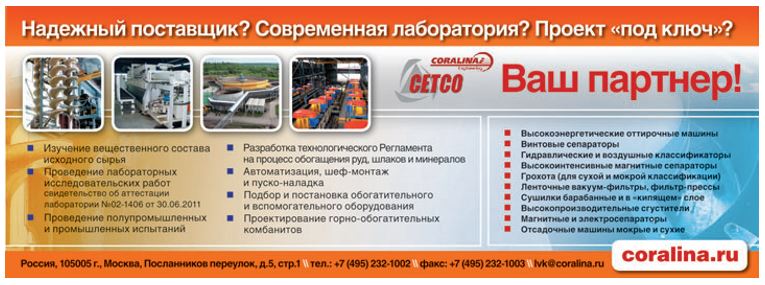Господдержка предприятий-производителей строительных материалов

Dear colleagues, good afternoon!
We are introducing you to the achievements of Koraline Engineering JSC, a member of the Association StekloSouz of Russia.
Alikin O.V., Chumakov A.V., Rudashevsky V.N., Rudashevsky N.S., Koshelchenkov L.V., Syrtsova O.V., Kanivets N.N., Shter V.K.
1 LLC "TsNT Instruments"
2 Saint Petersburg State University,
3 JSC "Koraline Engineering"
Features of phosphate mineralogy in ores of granular phosphorites of the Dzheroi-Sardara deposit (Republic of Uzbekistan)
The material composition of three samples of phosphorus-containing ores from productive strata of the Dzheroy Yuzhny site of the Dzheroi Sardara deposit (Republic of Uzbekistan) has been studied. The main forms of phosphorus (P2O5) occurrence in the rocks of the deposit have been diagnosed. The average content of phosphorus in wt. %.
Fig. 5, tab. 3, bibl. eleven.
Key words: phosphorus, granular phosphorites, 3D technology, hydroseparation, electric pulse disintegration, reservoir field, paleogene.
Dzheroi-Sardara granular phosphorite deposit is located in the Republic of Uzbekistan. It is confined to the intermontane depressions of the Kyzylkum ore field. Each depression in the form of a closed basin is composed of shallow-sea chalk deposits. They overlap the Paleozoic folded massifs and are underlying for marine limestone-marl-clay deposits of the Paleogene, containing products of underwater washings in the form of horizons with pebble, nodular and granular phosphorites [2].
V.S. Boyko et al. (1979) systematized the deposits of granular phosphorites in Central Asia on the basis of their textural-structural and lithological-facies features. According to this classification, the object under study belongs to the authigenic genetic group of the detrital structural type, that is, the ores were formed without significant transfer and redeposition, and the useful component (P2O5) is represented mainly by phosphatized organic residues. Later studies led by Kuchersky (2001) indicate that the Dzheroi-Sardara deposit is a benchmark among granular phosphorites.
Phosphorite beds are confined to Paleogene (Middle Eocene) deposits, which are composed of interbedded marls and clays. The surface configuration of the strata is usually slightly wavy. The structure of the host rocks is very homogeneous; there are no major tectonic faults (Obraztsov, 2001).
The authors investigated 3 samples of phosphorus-containing ores using 3D-technology of mineralogical-geochemical analysis (3D-technology). The samples are represented by one technological type and several lithological differences (Table 1).

The method of hydroseparation [6, 7, 8], which is the basis of 3D technology, makes it possible to separate grains of minerals according to their specific density. This method is effectively used to obtain technological products from the objects under study, including for the production of a "heavy" concentrate - mainly phosphorus minerals (apatite and fluorapatite), as well as sulfides. Additionally, it is possible to separate grains of productive minerals from the cement matrix - hydromica, feldspars and quartz.
In all the studied products, the team of authors established the main shaped components containing P2O5 (Table 2). According to the contents of the latter, in decreasing order: monomineral grains (phosphate concretions), oolites, detritus, aggregates of Fe-Ca phosphates with goethite, and cement matrix. It should be borne in mind that the ratio of shaped components in all samples is different. For example, in sample No. 1, cement material and phosphate aggregates predominate. This feature is due to the fact that the samples were taken from different layers, which differ in lithological composition.
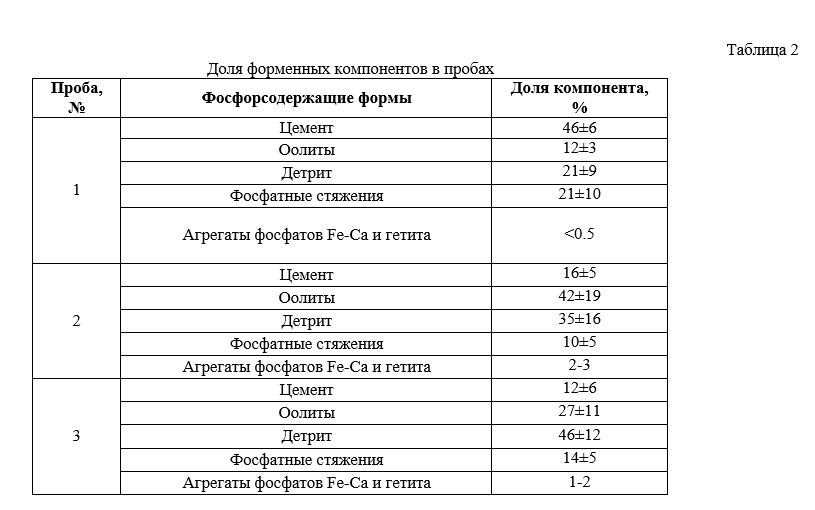
Accurate diagnostics of specific mineral species in the cement mass based on the results of microprobe analyzes is a non-trivial task and is complicated by the limitations of the method in the determination of light elements - oxygen, carbon and hydrogen, as well as the width of the electron beam.
The mineral forms of phosphorus in the Dzheroy-Sardara deposit are very diverse. In one of his works, the author (Obraztsov, 2001) identifies the main forms of phosphorus occurrence - francolite and carbonate-fluorapatite. At the same time, in the studied phosphorite ores, taphogenic (according to AA Korago, 1992) phosphate minerals are most pronounced. Taphobiogenic minerals formed upon the replacement of dead organic matter with minerals after burial include, for example, fluorapatite fossil, which replaced hydroxylapatite after burial (Newesely, 1989). Their accurate diagnosis is difficult due to the limited capabilities of the electron probe microanalysis of light components (O, H, C, etc.). The authors have identified two main varieties - apatite and fluorapatite. However, it should be understood that the types of phosphates can vary both in the degree of crystallinity (from completely amorphous to cryptocrystalline and crystalline), as well as in the content of hydroxides in the anionic group. The most complete list of mineral varieties of phosphates characteristic of phosphorites is given by V.T. Frolov (Table 3).

Consideration should be given to the considerable contribution of phosphate aggregates to the total share of the studied samples (10-20% of all phosphates). The largest amounts were found in samples No. 1 and No. 3. These are cryptocrystalline grains of irregular elongated shape, which in the course of microprobe analysis were identified as apatite and fluorapatite (Fig. 1). The average content of the useful component is ~ 33.5 wt. % Is one of the highest phosphorus contents among the uniform components in the studied samples.
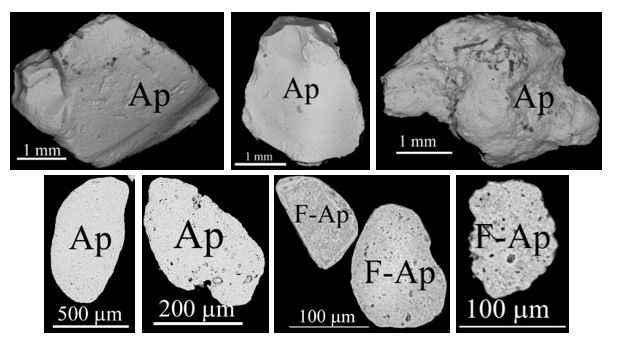
Fig. 1. Large bulk free grains of phosphate aggregates. Ap - apatite, F-Ap - fluorapatite Sample No. 1. EID product, manual selection. SEM photo.
Oolitic microconcretions make a large contribution to the proportion of shaped components in phosphorite samples. The most common type (60-80% of all oolites) are various intergrowths of calcite, fluorapatite and apatite (Fig. 2). The marginal parts of such oolites have a zonal concentric-layered structure (interlayers up to 10 μm), and the central part of oolites is usually completely filled with phosphate matter. Sometimes the cores of oolites are composed of grains of terrigenous minerals. Average contents of P2O5 oolites ~ 32.2-34.5 wt. %.
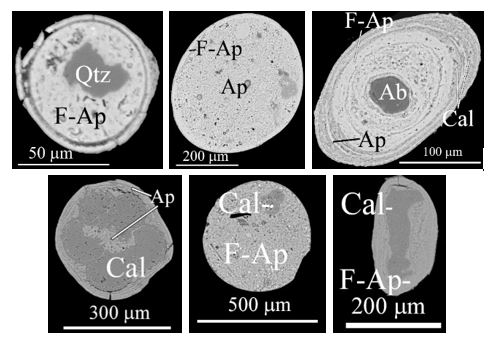
Fig. 2. Typical grains-carriers of phosphates: oolites (microconcretions) of various compositions. Polished sections of "heavy" HS-concentrates. F-Ap - fluorapatite, Ap - apatite, Cal - calcite, Ab - albite, Qtz - quartz.
The main carriers of phosphates are both detritus (partial or complete replacement of the skeleton of microorganisms) and oolites (microconcretions). Foraminifera, scaphopods, ostracods, etc. are typical microorganisms in the studied samples (Fig. 3). The main minerals that replace shells are calcite and fluorapatite. The phosphorus content in detritus varies within a narrow range of P2O5 ~ 32.4-32.8 wt. %.
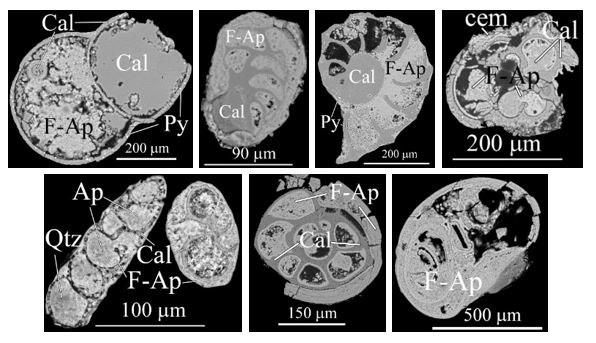
Fig. 3. Typical grains-carriers of phosphates: detritus (fragments of shells of foraminifera, ostracods, etc.). EID products of phosphorite ore samples.
In “heavy” HS-concentrates, the team of authors discovered aggregates of Fe-Ca phosphates with goethite, which are accessory to the studied phosphorite ores. Sample No. 3 also contains single grains of anapaite and native copper, which indicates intensive oxidation processes, probably associated with a change in the paleoenvironment during the formation of the deposit (Fig. 4).

Fig. 4. Indicators of superimposed oxidation processes: aggregates of anapaite, native copper and Fe-Ca phosphates and goethite. F-Ap - fluorapatite, Ap - apatite, Cal - calcite, Cu - native copper, Gt - goethite, Anp - anapaite Ca2Fe (PO4) 2 • 4 (H2O).
The main feature of the cement in the material of the studied samples is its wide variability in the main components: in sample No. 1, clay-lime and clay-sulphate-lime aggregates prevail (> 60%), in sample No. 2 - clay-lime and phosphate-clay-lime (%), and in sample No. 3 - clay-lime and sulfate-phosphate-lime. Among the phosphorus-containing ones, the most common is clay-sulphate-lime cement (P2O5 ~ 1.8-3.1 wt.%). It is worth noting also rare areas of the cement matrix, where the P2O5 content reaches 8.5-17.1 wt. % (Fig. 5).

Fig. 5. Aggregates of cement masses, phosphates and carbonates of various composition: Ap - apatite, F-Ap - fluorapatite, Cal - calcite, Qtz - quartz, Ca-Si-P - phosphate-siliceous-calcareous cement; Ca-Si-S - sulphate-siliceous-lime cement, Cal-Al-S and Cal-Al-K - clay-sulphate-lime cement.
The use of 3D technology of mineralogical and geochemical studies made it possible to characterize in detail the mineral composition of phosphorite-containing ores of the Dzheroi South Dzheroi-Sardarinskoye deposit, as well as to reveal their similarities and differences. The main phosphate in all samples is fluorapatite. Apatite in various shaped components, aggregates and intergrowths of Fe-Ca and goethite are found in subordinate amounts in all samples. Sample No. 3 is characterized by the appearance of oxidation zone minerals - anapaite and native copper.
The data obtained make a significant contribution to the study of the mineralogy of granular phosphorites. For a more detailed establishment of the patterns of distribution of phosphorus minerals, more accurate diagnostics, as well as to trace the dynamics of their behavior in the enrichment process, technological studies will be carried out at the Mineral Raw Materials Research Center of Koralina Engineering JSC, followed by a mineralogical study of technological products (concentrates, intermediate products and tailings) at TsNT Instruments LLC.
